End-Fire Antenna for BAN at 60 GHz: Impact of Bending, On-Body Performances, and Study of an On to Off-Body Scenario
Abstract
:1. Introduction
2. Antenna Model and Characteristics
2.1. Antenna Model
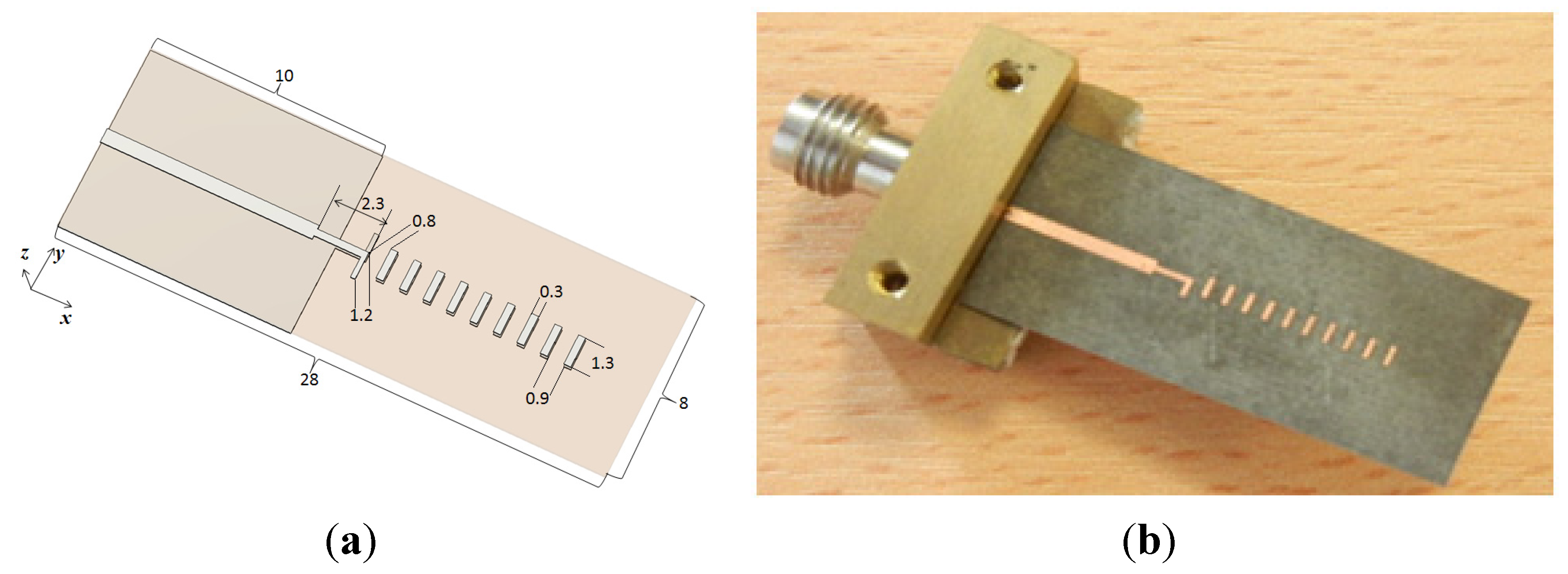
2.2. Reflection Coefficient
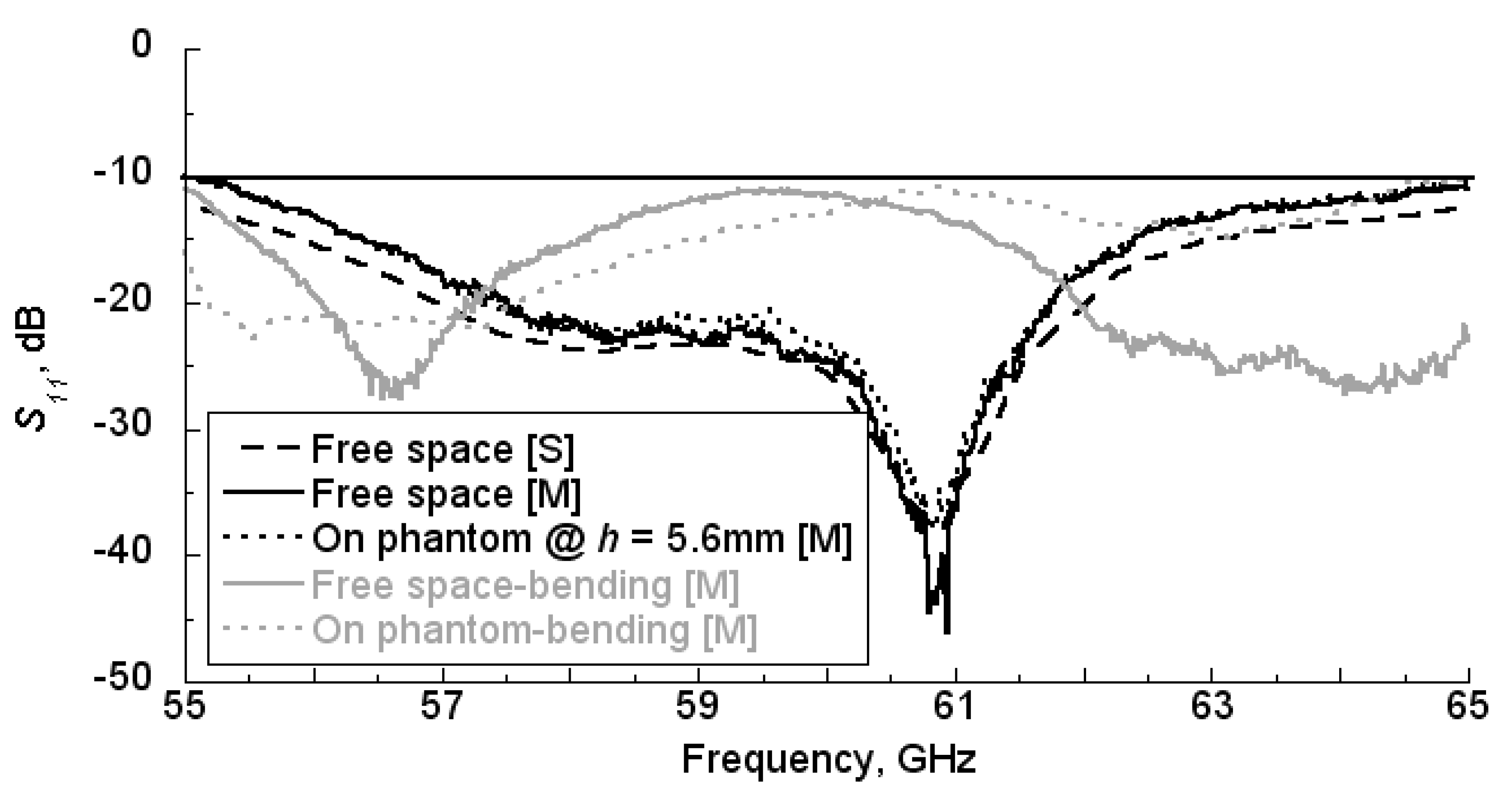
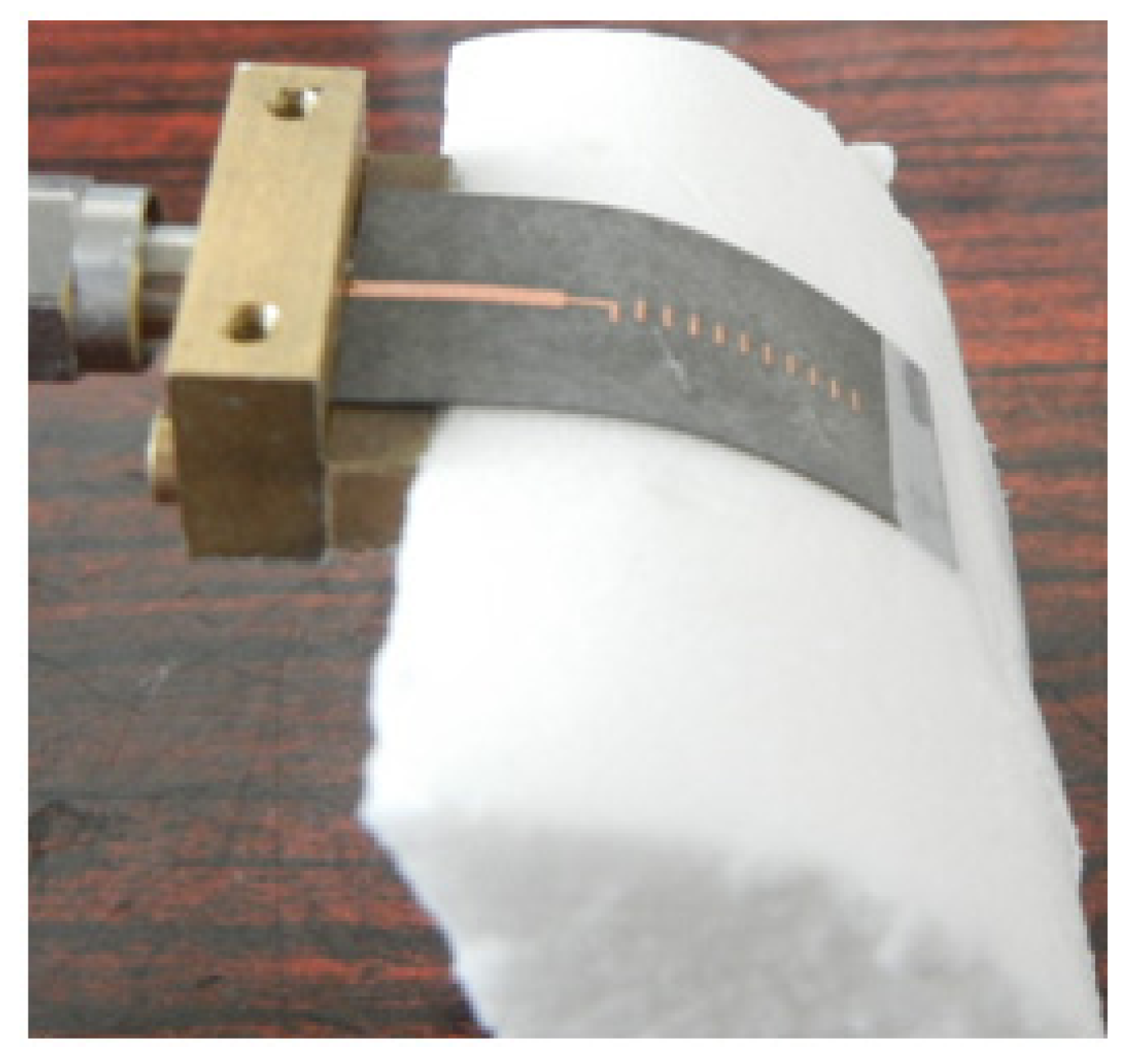
2.3. Radiation Patterns
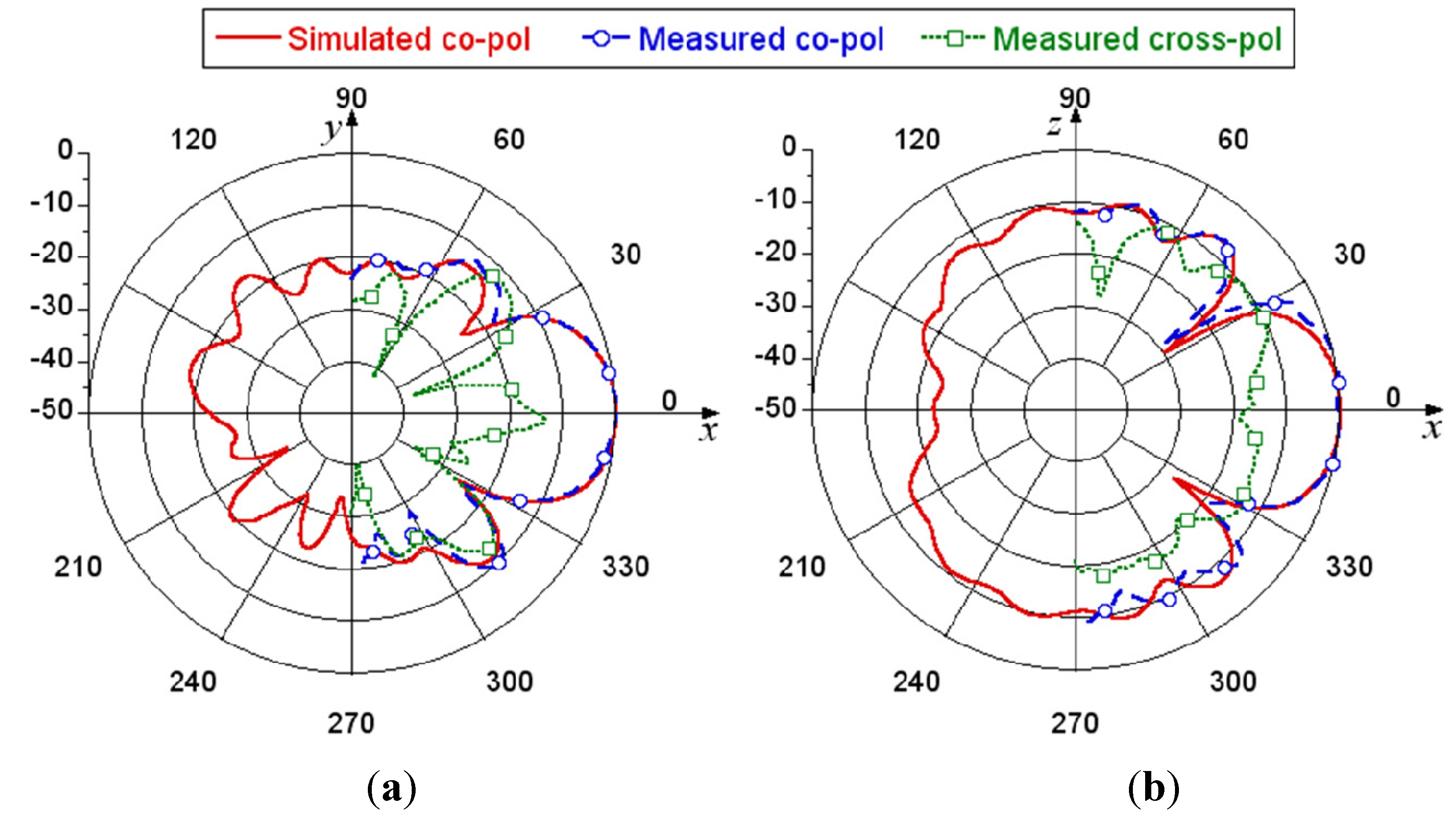
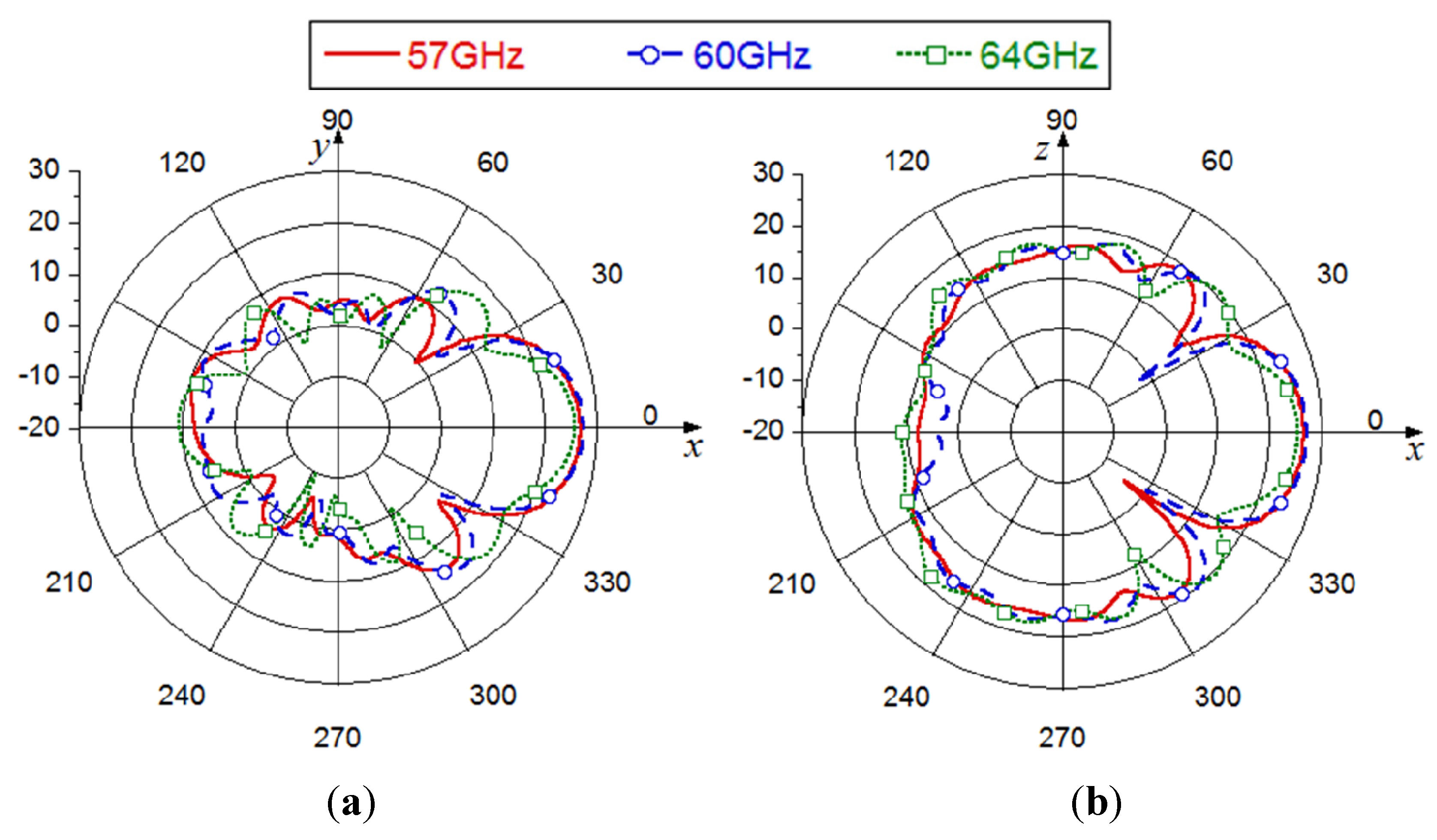
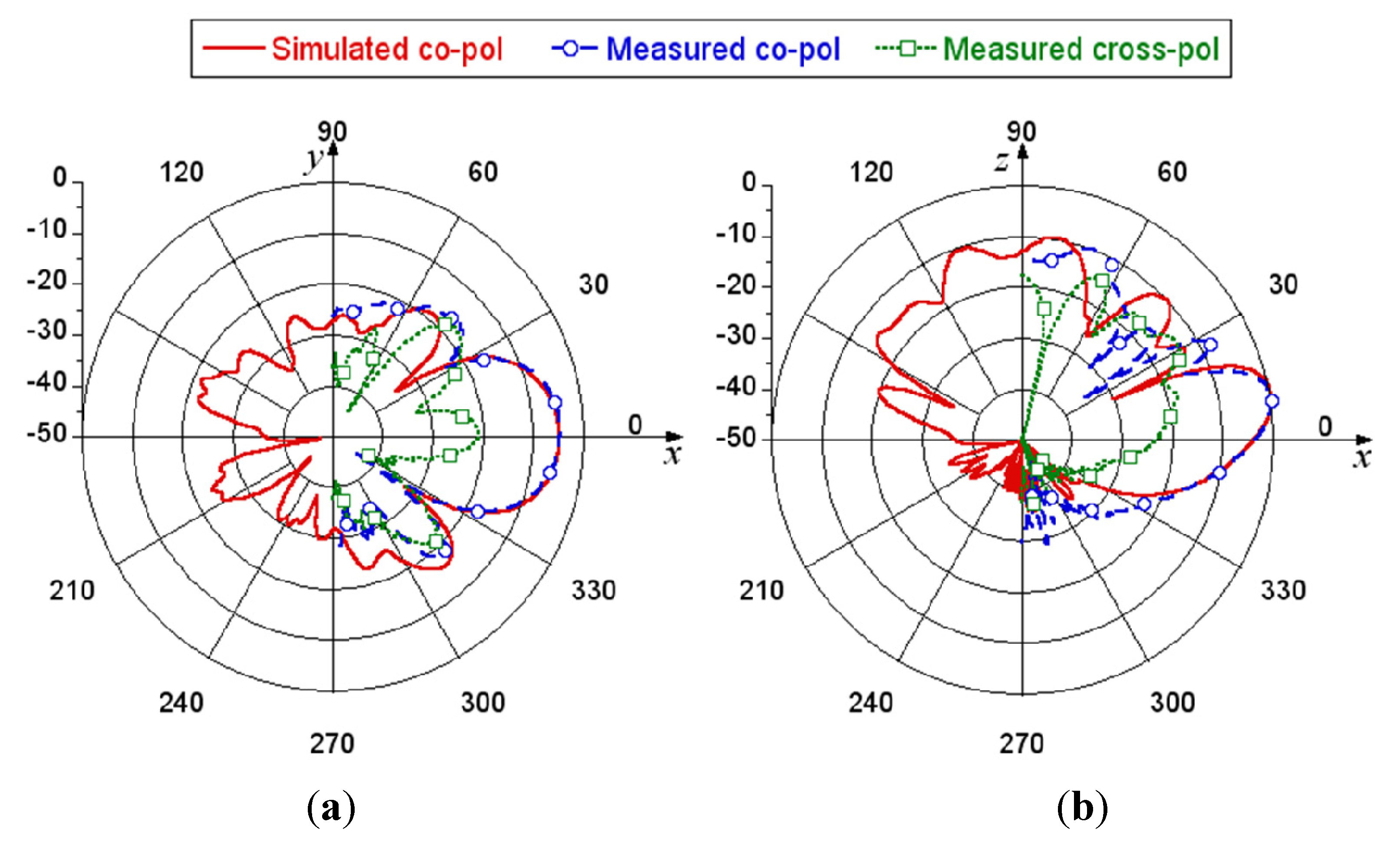
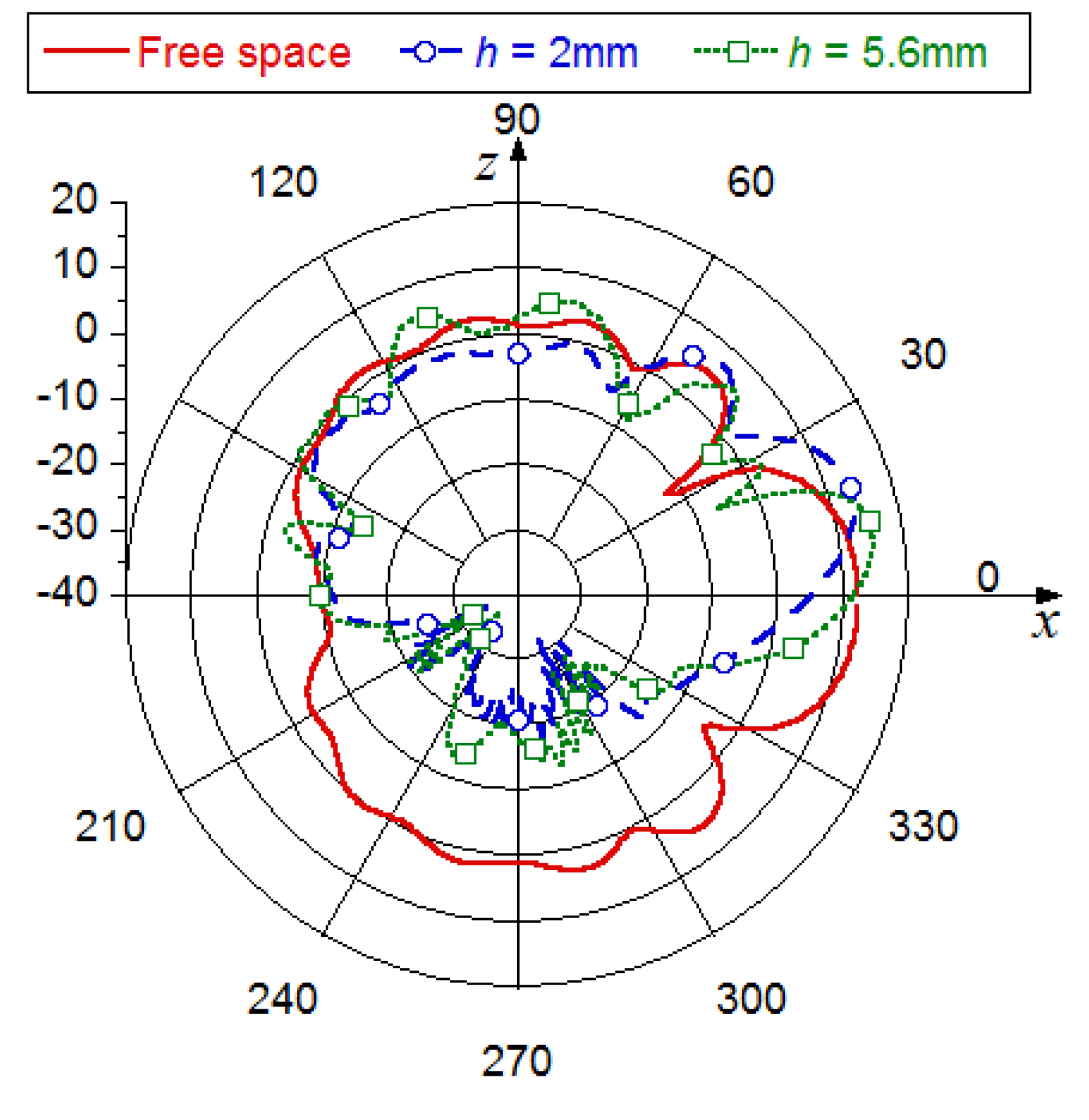
| Antenna position | Gain [dBi] (@ 60 GHz) | Efficiency [%](@ 60 GHz) | |
| Simulated | Measured | Simulated | |
| Free space | 12.1 | 11.8 | 92.2 |
| h = 5.6 mm | 15.1 | 15.2 | 75.2 |
| h = 2 mm | 13.6 | 13.6 | 68.2 |
| Absorbed power [mW] | Peak SAR1g [W/kg] | |
|---|---|---|
| h = 5.6 mm | 2.4 | 1.03 |
| h = 2 mm | 3.2 | 1.67 |

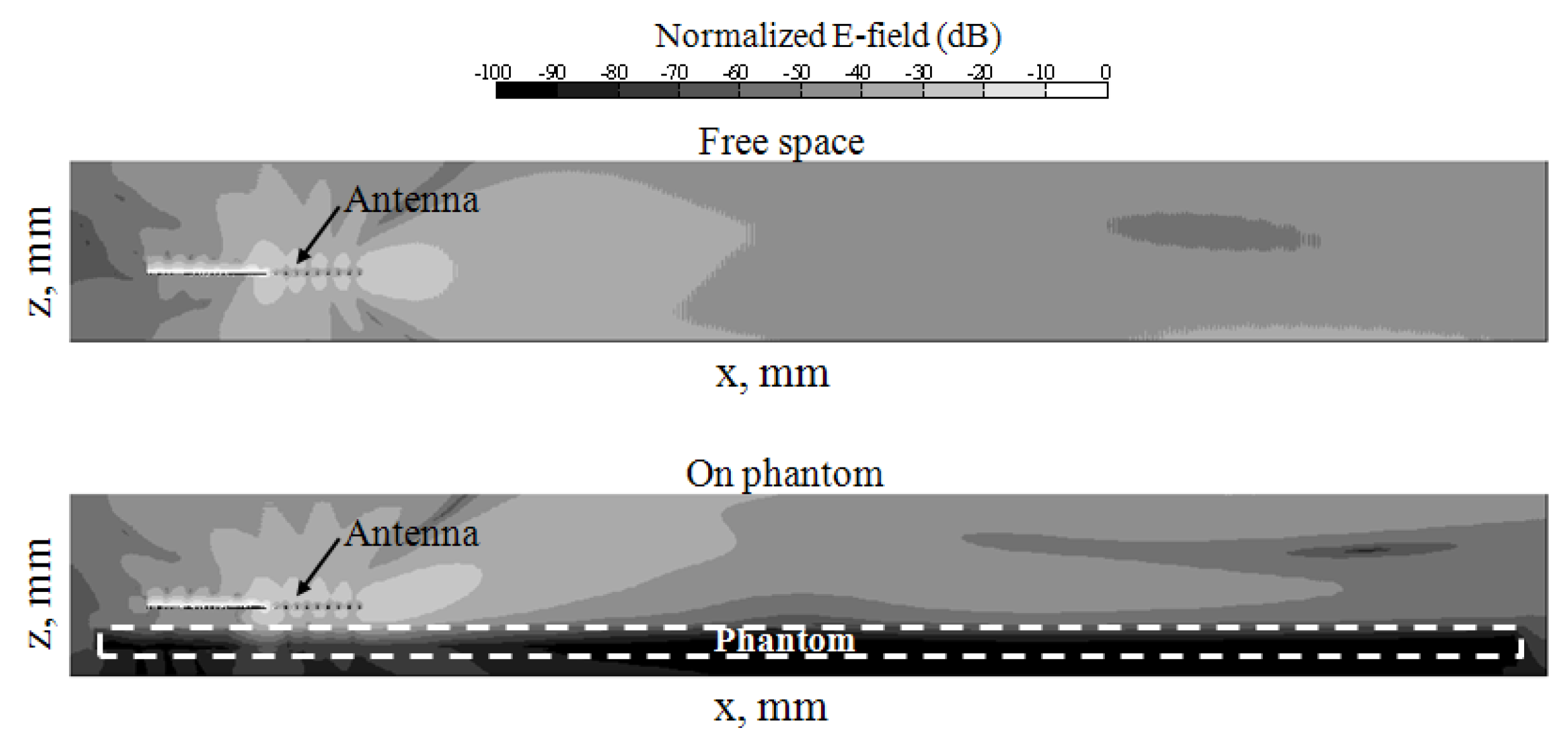

3. On to off Body Propagation

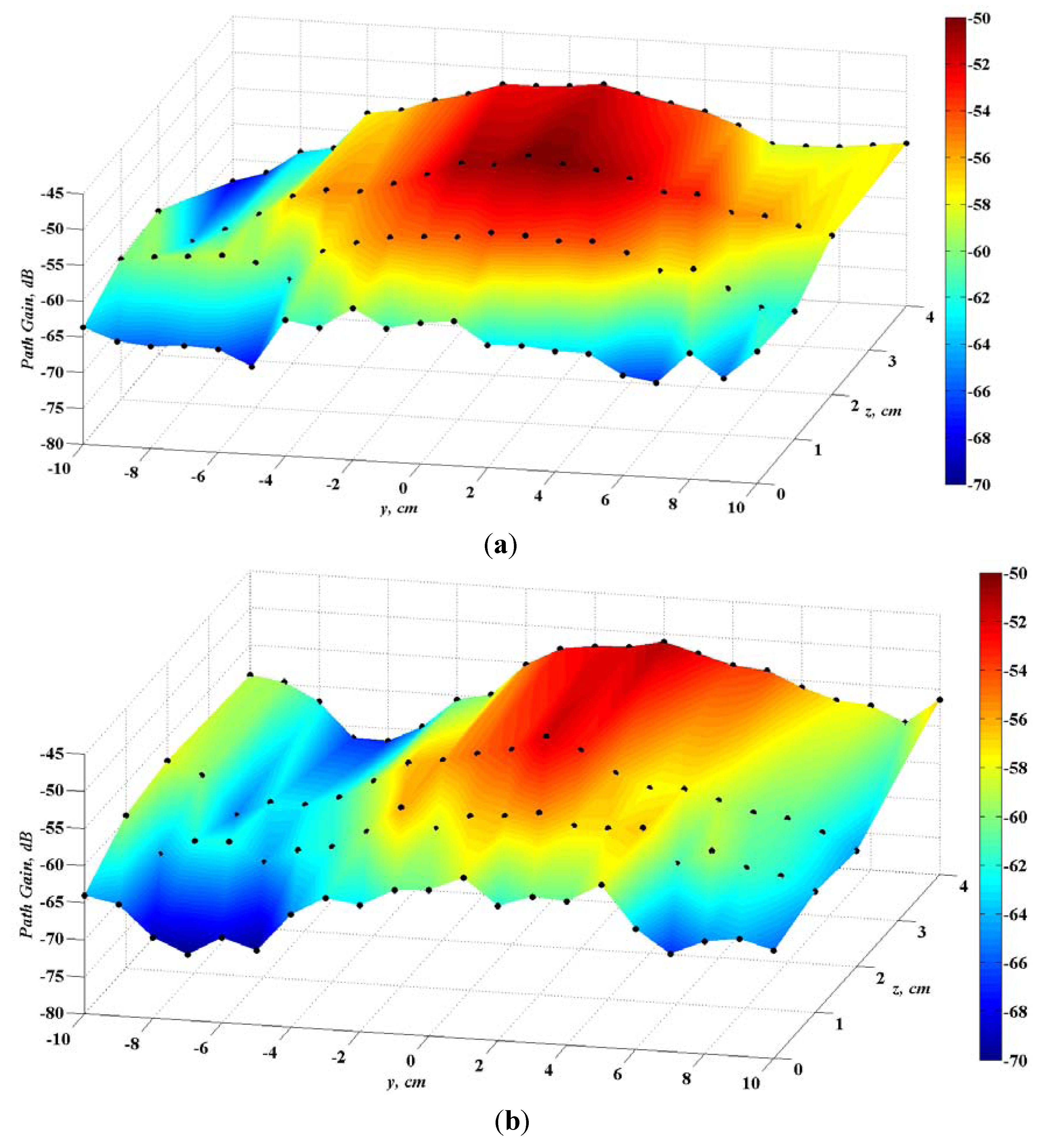
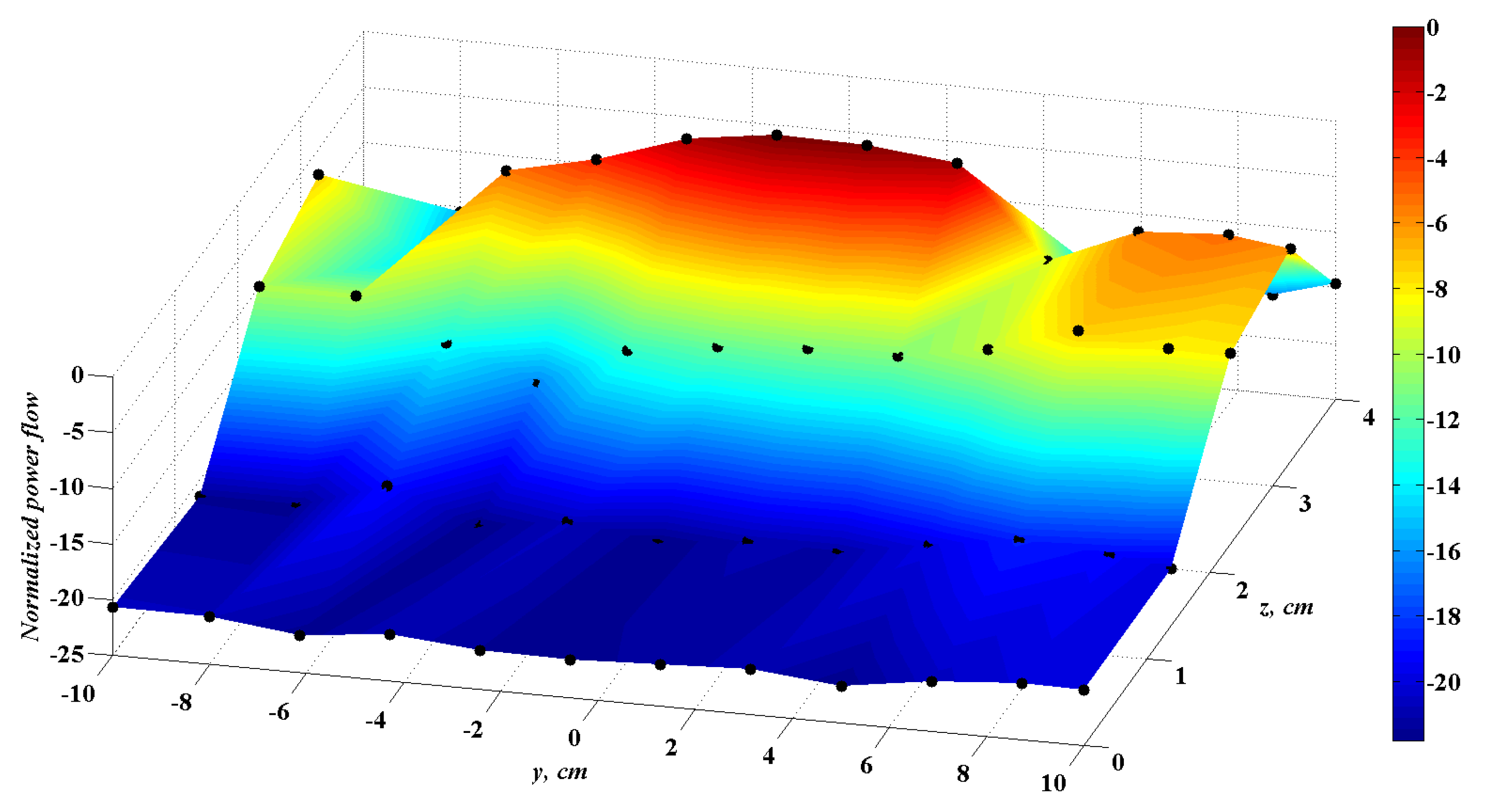
4. Conclusions
Acknowledgments
Conflicts of Interest
References
- Pellegrini, A.; Brizzi, A.; Zhang, L.; Ali, K.; Hao, Y.; Wu, X.; Constantinou, C.C.; Nechayev, Y.; Hall, P.S.; Chahat, N.; et al. Antennas and propagation for body centric wireless communications at millimeter wave frequencies: A review. IEEE Antennas Propag. Mag. 2013, 55, 262–287. [Google Scholar]
- Cotton, S.C.; Scanlon, W.G.; Madahar, B.K. Millimeter-wave soldier-to-soldier communications for covert battlefield operations. IEEE Commun. Mag. 2009, 47, 72–81. [Google Scholar] [Green Version]
- Baykas, T.; Sum, C.S.; Lan, Z.; Wang, J.; Rahman, M.A.; Harada, H. IEEE 802.15.3c: The first IEEE wireless standard for data rates over 1 Gb/s. IEEE Commun. Mag. 2011, 49, 114–121. [Google Scholar]
- Cotton, S.C.; Scanlon, W.G.; Hall, P.S. A simulated study of co-channel inter-BAN interference at 2.45 GHz and 60 GHz. In Proceedings of the Wireless Technology Conference (EuWIT), Paris, France, 27–28 September 2010; pp. 61–64.
- Alipour, S.; Parvaresh, F.; Ghajari, H. Propagation characteristics for a 60 GHz wireless body area network (WBAN). In Proceedings of the Military Communications Conference, Proceedings of the Military Communications Conference, 31 October 2010–3 November 2010; pp. 719–723.
- Chahat, N.; Zhadobov, M.; Alekseev, S; Sauleau, R. Human skin-equivalent phantom for on-body antenna measurements in the 60-GHz band. Electron. Lett. 2012, 48, 67–68. [Google Scholar] [CrossRef]
- Chahat, N.; Valerio, G.; Zhadobov, M.; Sauleau, R. On-body propagation at 60 GHz. IEEE Trans. Antennas Propag. 2013, 61, 1876–1888. [Google Scholar] [CrossRef]
- Guraliuc, A.R.; Zhadobov, M.; Valerio, G.; Chahat, N.; Sauleau, R. Effect of textile on the propagation along the body at 60 GHz. IEEE Trans. Antennas Propag. 2014, 62, 1489–1494. [Google Scholar]
- Zhadobov, M.; Chahat, N.; Sauleau, R.; Le Quément, C.; Le Dréan, Y. Millimeter-wave interactions with the human body: State of knowledge and recent advances. Int. J. Microw. Wirel. Technol. 2011, 3, 237–247. [Google Scholar] [CrossRef]
- Wu, X.; Akhoondzadeh-Asl, L.; Wang, Z.; Hall, P.S. Novel Yagi-Uda antennas for on-body communication at 60 GHz. In Proceedings of the Antennas and Propagation Conference (LAPC), Loughborough, UK, 8–9 November 2010; pp. 153–156.
- Wu, X.; Akhoondzadeh-Asl, L.; Hall, P.S. Printed Yagi-Uda array for on-body communication channels at 60 GHz. Microw. Opt. Technol. Lett. 2011, 53, 2728–2730. [Google Scholar] [CrossRef]
- Chahat, N.; Zhadobov, M.; Sauleau, R. Wearable textile patch antenna for BAN at 60 GHz. In Proceedings of the 7th European Conference on Antennas and Propagation (EuCAP), Gothenburg, Sweden, 8–12 April 2013; pp. 209–211.
- Chahat, N.; Zhadobov, M.; Le Coq, L.; Sauleau, R. Wearable end-fire textile antenna for on-body communications at 60 GHz. IEEE Antennas Wirel. Propag. Lett. 2012, 11, 799–802. [Google Scholar] [CrossRef]
- Chahat, N.; Leduc, C.; Zhadobov, M.; Sauleau, R. Antennas and interaction with the body for body-centric wireless communications at millimeter-waves. In Proceedings of the 7th European Conference on Antennas and Propagation (EuCAP), Gothenburg, Sweden, 8–12 April 2013; pp. 757–760.
- Dey, S.; Saha, N.; Alomainy, A. Design and performance analysis of narrow band textile antenna for three different substrate permittivity materials and bending consequence. In Proceedings of the Antennas and Propagation Conference (LAPC), Loughborough, UK, 8–9 November 2010; pp. 1–5.
- Hertleer, C.; Tronquo, A.; Rogier, H.; Vallozzi, L.; van Langenhove, L. Aperture-coupled patch antenna for integration into wearable textile systems. IEEE Antennas Wirel. Propag. Lett. 2007, 6, 392–395. [Google Scholar] [CrossRef]
- Amaro, N.; Mendes, C.; Pinho, P. Bending effects on a textile microstrip antenna. In Proceedings of the IEEE International Symposium on Antennas and Propagation (APSURSI), Spokane, WA, USA, 3–8 July 2011; pp. 282–285.
- Locher, I.; Klemm, M.; Kirstein, T.; Troster, G. Design and characterization of purely textile patch antennas. IEEE Trans. Adv. Packag. 2006, 29, 777–788. [Google Scholar] [CrossRef]
- Bai, Q.; Langley, R. Crumpling of PIFA textile antenna. IEEE Trans. Antennas Propag. 2012, 60, 63–70. [Google Scholar] [CrossRef]
- Zhu, S.; Langley, R. Dual-band wearable textile antenna on an EBG substrate. IEEE Trans. Antennas Propag. 2009, 57, 926–935. [Google Scholar] [CrossRef]
- Chahat, N.; Zhadobov, M.; Sauleau, R. Broadband tissue-equivalent phantom for BAN applications at millimeter waves. IEEE Microw. Theory Technol. 2012, 60, 2259–2266. [Google Scholar] [CrossRef]
- Wong, K.L.; Lin, C.I. Characteristics of a 2.4-GHz compact shorted patch antenna in close proximity to a lossy medium. Microw. Opt. Technol. Lett. 2005, 45, 480–483. [Google Scholar] [CrossRef]
- Hall, P.S.; Hao, Y.; Nechayev, Y.I.; Alomainy, A.; Constantinou, C.C.; Parini, C.; Kamarudin, M.R.; Salim, T.Z.; Hee, D.T.M.; Dubruvka, R.; et al. Antennas and propagation for on-body communication systems. IEEE Antennas Propag. Mag. 2007, 49, 41–58. [Google Scholar] [CrossRef]
- Chahat, N.; Zhadobov, M.; Sauleau, R.; Ito, K. A compact UWB antenna for on-body applications. IEEE Trans. Antennas Propag. 2011, 59, 1123–1131. [Google Scholar] [CrossRef]
- Khan, M.M.; Alomainy, A.; Hao, Y. Dual band and diverse radiation pattern antenna for power efficient and reliable on-body and off-body communications for healthcare applications. In Proceedings of the IEEE International Symposium on Antennas and Propagation (APSURSI), Spokane, WA, USA, 3–8 July 2011; pp. 396–399.
- Islam, M.R.; Chamok, N.H.; Ali, M. Switched parasitic dipole antenna array for high-data-rate body-worn wireless applications. IEEE Antennas Wirel. Propag. Lett. 2012, 6, 693–696. [Google Scholar] [CrossRef]
- Gabriel, S.; Lau, W.; Gabriel, C. The dielectric properties of biological tissues: III. Parametric models for the dielectric spectrum of tissues. Phys. Med. Biol. 1996, 41, 2271–2293. [Google Scholar] [CrossRef]
© 2014 by the authors; licensee MDPI, Basel, Switzerland. This article is an open access article distributed under the terms and conditions of the Creative Commons Attribution license (http://creativecommons.org/licenses/by/3.0/).
Share and Cite
Guraliuc, A.R.; Chahat, N.; Leduc, C.; Zhadobov, M.; Sauleau, R. End-Fire Antenna for BAN at 60 GHz: Impact of Bending, On-Body Performances, and Study of an On to Off-Body Scenario. Electronics 2014, 3, 221-233. https://doi.org/10.3390/electronics3020221
Guraliuc AR, Chahat N, Leduc C, Zhadobov M, Sauleau R. End-Fire Antenna for BAN at 60 GHz: Impact of Bending, On-Body Performances, and Study of an On to Off-Body Scenario. Electronics. 2014; 3(2):221-233. https://doi.org/10.3390/electronics3020221
Chicago/Turabian StyleGuraliuc, Anda R., Nacer Chahat, Carole Leduc, Maxim Zhadobov, and Ronan Sauleau. 2014. "End-Fire Antenna for BAN at 60 GHz: Impact of Bending, On-Body Performances, and Study of an On to Off-Body Scenario" Electronics 3, no. 2: 221-233. https://doi.org/10.3390/electronics3020221
APA StyleGuraliuc, A. R., Chahat, N., Leduc, C., Zhadobov, M., & Sauleau, R. (2014). End-Fire Antenna for BAN at 60 GHz: Impact of Bending, On-Body Performances, and Study of an On to Off-Body Scenario. Electronics, 3(2), 221-233. https://doi.org/10.3390/electronics3020221





